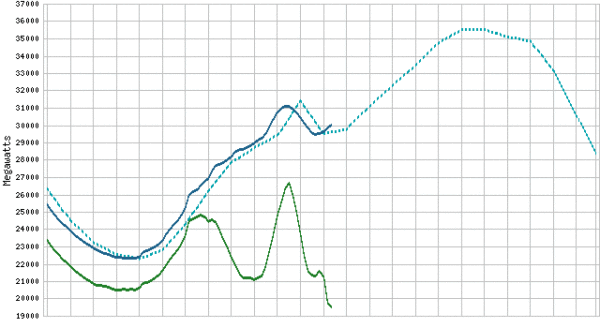As we move to higher penetrations of wind and solar on the grid, there arises a significant question as to how much the remaining conventional resources on the grid can respond to rapid changes in wind and solar production, in other words, how well they can “ramp”. And today, the most significant test of California’s grid and its ramping capabilities to date came, in the form of a partial eclipse.
Between roughly 9-11:30 AM local time, the shadow of the moon obscured the sun from 76% to 56% across the state, causing a significant decline in the roughly 18 GW of solar that is online. According to charts by California ISO, solar going off-line meant that the system needed a temporary 5 GW injection of extra power.

The result? Not much. “Things went really really well,” noted California Independent System Operator (CAISO) VP of Operations Eric Schmitt. “Our market performed very well, with very little operator intervention.”
ISO was not able to say exactly the portion of various resources that went into addressing power needs during the eclipse, except that it included extra hydroelectric power and natural gas generation. CAISO has declined to comment on the role of battery storage, but Schmitt stated that the “relationship of resources is what we anticipated”. CAISO also notes that it did not put a call out for demand response.
The extra 5 GW included resources from out of state, provided through the regional Energy Imbalance Market (EIM) initiated by CAISO. On a conference call which started at around 11:30 local time, CAISO noted that once the sun returned, California began to export on the EIM.
Additionally, this led to a period of negative prices and limited curtailment of solar. California experiences recurring negative prices due to a combination of variable generation from wind and solar an inflexible resources and operating practices, which includes 24/7 output from the state’s sole remaining nuclear power plant.
CAISO says that while the event was challenging, that it remains ready for “anything”. Schmitt credits “planning, planning and more planning” for the event, and if planning can allow the grid operator to handle such an unusual event with no problems, it bodes well for a future of integrating large amounts of wind and solar.
This content is protected by copyright and may not be reused. If you want to cooperate with us and would like to reuse some of our content, please contact: editors@pv-magazine.com.









By submitting this form you agree to pv magazine using your data for the purposes of publishing your comment.
Your personal data will only be disclosed or otherwise transmitted to third parties for the purposes of spam filtering or if this is necessary for technical maintenance of the website. Any other transfer to third parties will not take place unless this is justified on the basis of applicable data protection regulations or if pv magazine is legally obliged to do so.
You may revoke this consent at any time with effect for the future, in which case your personal data will be deleted immediately. Otherwise, your data will be deleted if pv magazine has processed your request or the purpose of data storage is fulfilled.
Further information on data privacy can be found in our Data Protection Policy.